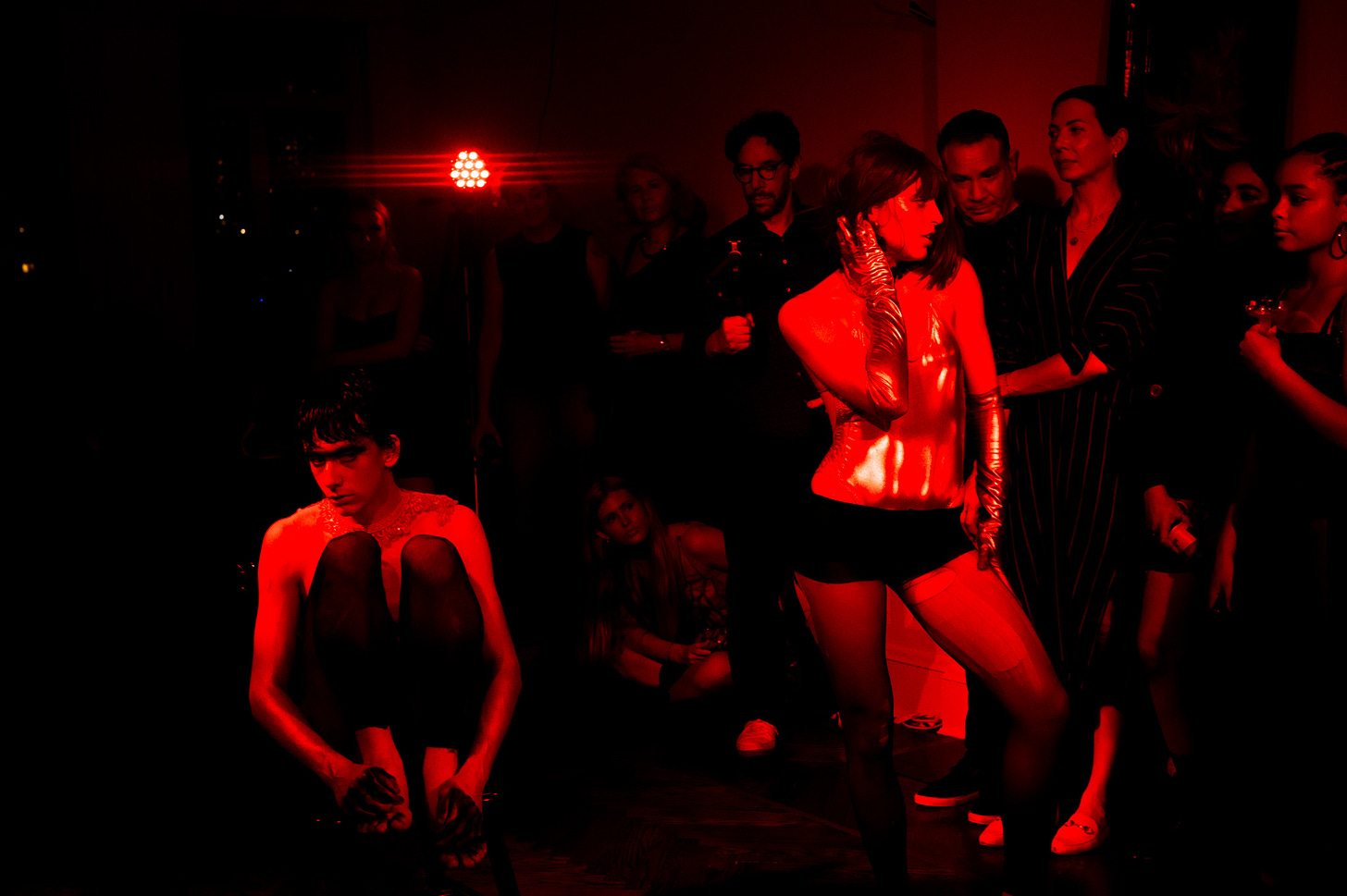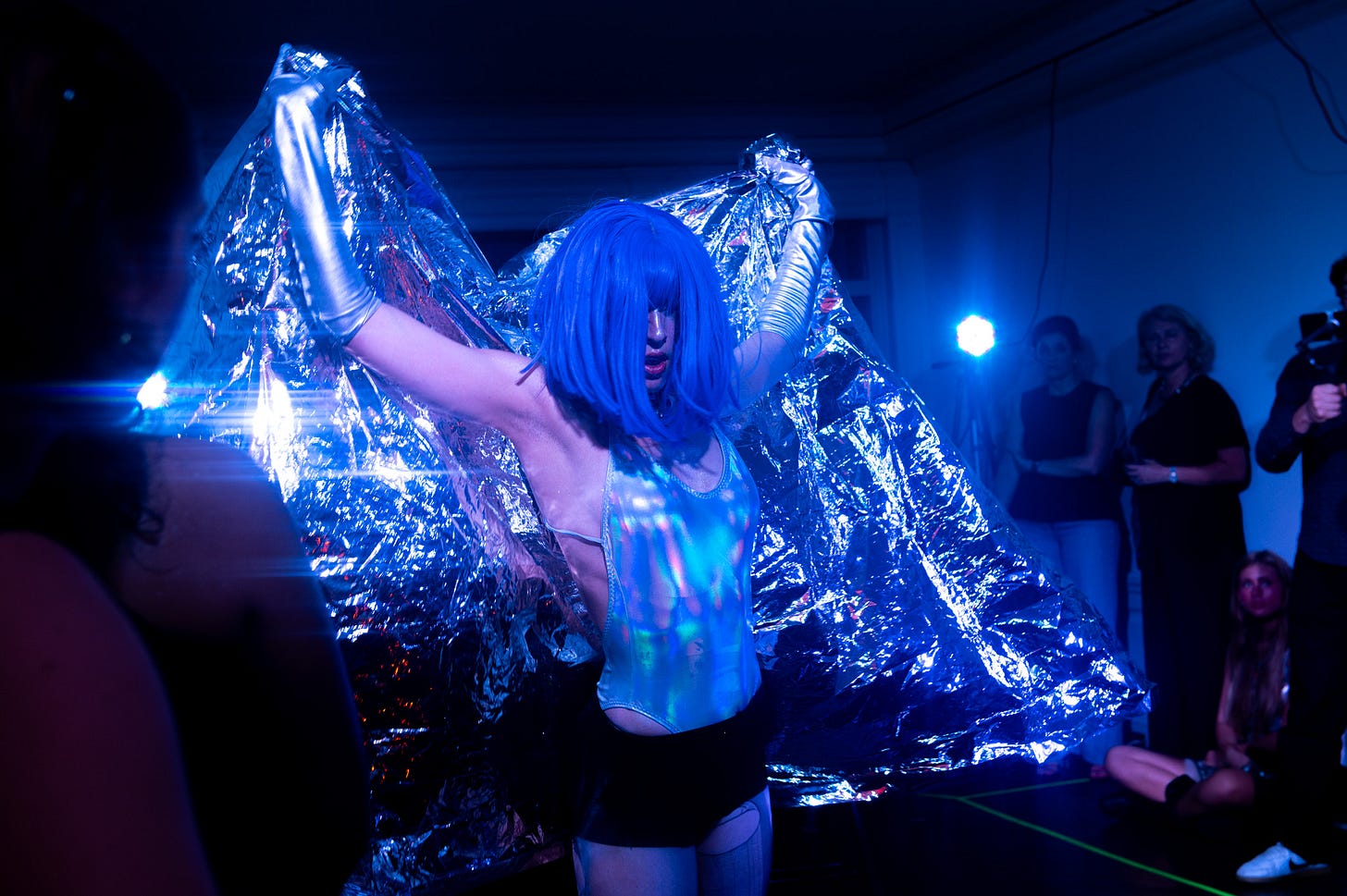All the Downtown Kids, Uptown
“s3xtechno” blurs the lines between dance, theater, and rave culture to rapturous effect.
How do you write about a friend’s art with objectivity? It’s a challenge not only because of the obligations that come with friendship, but the pride you take in their work.
This was the question I faced last Tuesday night at “s3xtechno” by Felix Gaddie, a 20-year-old choreographer and dancer who happens to be my close friend.
Lucky for this writer, the show is undeniably compelling. Starring Gaddie and Azalea Brown, both students at Northwestern University, “s3xtechno” blurs the lines between dance, theater, and rave culture to rapturous effect.
The show, which debuted at Northwestern last month, explores pressing questions about human intimacy with technology. Gaddie has said he took inspiration from the emotional bonds that humans are increasingly forming with artificial intelligence, including the story of a teenage boy whose suicide followed his obsession with a chatbot.
Although it keeps away from the details of that tragedy, “s3xtechno” dramatizes a similar interplay of connection and destruction through a duet between Gaddie and Brown, who portray a man and a feminized chatbot, though the boundaries between human and non-human aren’t always clear.
Having assembled a group of collaborators in college, Gaddie and producer Kat Tuohy, a recent graduate of Northwestern, decided to bring their show to Manhattan, where he and I met in the ninth grade.
For as long as I’ve known him, Gaddie has drawn crowds with his jet-black hair, larger-than-life personality, and commitment to artistic expression, and Tuesday was no exception. The performance doubled as a kind of homecoming for the many friends in Gaddie’s orbit, including former high school classmates who had lost touch since graduating and leaving the city. No one, it seemed, wanted to miss this.
Our reunions began on the sidewalk in front of The Beresford, a storied apartment building on the Upper West Side and the venue for the show. Golden light from the lobby of the building spilled onto the street, while Tuohy ushered us through the doors in a black dress and heart-shaped necklace. Though rush tickets at the door were supposed to cost $25, Gaddie’s friends got away with a $5 discount.
After crowding into an old-fashioned elevator, we rose to the 15th floor, home to Ginevra, another high school friend. The apartment was relatively new, and she’d offered up the place to Gaddie and Tuohy after another venue in Brooklyn fell through.
Ginevra and a few others were already manning a makeshift bar when we walked into the apartment, serving hard seltzers and jello shots. Though it was still mostly unfurnished, the room had the feel of a nightclub crossed with a scene from Whit Stillman’s Metropolitan. Colored lights glinted from the metal of necklaces, bracelets, and a handmade cyborgian bra. By my estimate, the audience of 60 people was mostly in their early twenties, with some older exceptions. At the corner of the room, I spied Ellen Robbins, a veteran SoHo dance teacher who mentored Gaddie when he was young.
Conversation alternated between ordinary small talk and eager anticipation of the show. “I can’t wait to see their bodies move together,” my friend Emma told me, lacing her voice with dry humor. “You can quote me on that.”
The party’s gravity soon shifted to a spare, white-walled room whose windows overlooked Central Park and the American Museum of Natural History. The audience lined the space, craning their necks for the best view of the center of the room. Colored lights overheard saturated us in blue and red, while two young women in black, DJ Lucy Rubinstein (known by her stage name “r00bies4ever”) and production manager Lulu Abratha, controlled the music and lighting from their laptops.
The room was already getting humid, drops of sweat beginning to fall from our brows. Still, we waited patiently, aware that Gaddie and Brown were probably one room over, preparing in the manic ways that performing artists do.
Just as our anticipation began to peak, Gaddie strode in wearing only tights and metallic paint across his body. Cutting through the silence of the room, he perched himself on a chair for several minutes, arching his limbs around its structure, only to leave just as abruptly.
“He’s, like, edging us,” I heard someone say.
Returning to the chair, he wore an expression of vulnerability and fear directed at Brown, who was visible through the glass pane of a french door. She wore a metallic leotard and blue wig that resembled Scarlett Johansson’s look from Lost In Translation.
“What’s in a name?” asked a recorded monologue over the speaker, alluding to Romeo and Juliet. “Are we all techsexual?…It’s bound to happen with an AI chatbot.”
The duo began to dance, their bodies caught in a tug-of-war between seduction and violence, function and dysfunction. Gaddie’s frequent wails of heartbreak, met with indifference from Brown, pierced the room.
A few days later, Brown joked to me that the show largely consists of Gaddie “having a mental breakdown” onstage while she “serves.” At several points, Brown confronted members of the audience face-to-face, her wide, Emma Stone-like eyes delivering an uncanny stare.
Rather than laughing or looking away, audience members met Brown’s eyes with deadly seriousness. Her gaze was intimidating, even as she invited us to participate in the scene.
Maybe this was what art always felt like at first, I thought, and theater most of all. A crowd of people standing together in a blank room, playing make-believe until their fantasy comes true.
Lighting shifts punctuated the relationship between the two dancers, which progressed through a series of increasingly violent movements. The pair mirrored each other as they vibrated their limbs. Brown cloaked herself in a foil blanket, armoring herself and simultaneously reflecting the man’s gaze back to him. I noticed that Robbins, Gaddie’s former dance teacher, was examining every movement of the dancers’ muscles.
By the end of the performance, Brown’s wig was gone, as if to mark her passage from machine to human. She howled in triumphant laughter while a desperate Gaddie kissed his arms and body.
“We all want to be loved,” said the voice over the speaker. “We all want to be touched.” Despite the vagueness of the statement, it had a convincing universality given the scene on the floor, across which Brown was now dragging Gaddie’s limp body. Love, or the feeling of being known, often leads humans to risk everything, even life itself.
The intimacy of “s3xtechno” spoke to a generational concern, too — the so-called “sex recession” among young people, who are far less sexually active than generations before them. Going a step beyond the current discourse over Gen Z’s celibacy, the performance asked if sexuality might not be declining, but evolving. In other words, what’s in a name? Might we all be techsexual, seduced by our screens and personalized algorithms?
Forgoing a blackout or the usual bows at the end of a show, Gaddie left his audience weighing these questions through dance. He and Brown pulled several unsuspecting people from the edge of the room to its center, where they began moving to the music. Even after Gaddie and Brown left the room, the DJ continued to play ravelike beats over the speakers, creating the best transition to an after-party I’ve ever seen.
As the room began to dance together, I grinned at the ingenuity of my friend. His performance wasn’t a self-aggrandizing gesture, but an effort to unite a room of young people who cared passionately about art and the possibility of connection. I could’ve danced all night.






